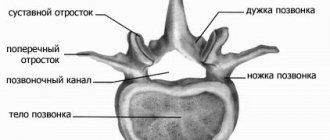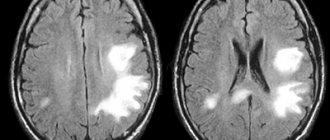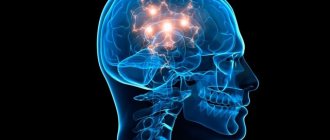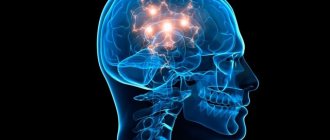Neuron: fiber, nerve.
The function of neurons is to create and conduct nerve impulses. A typical neuron takes 1 microsecond to respond to a stimulus. Millions of neurons respond in unison, producing “swinging” electrical discharges. This response creates a brain rhythm called a “brain wave.” The state of our consciousness reflects the mixed activity of the rhythms of such waves. Electroencephalogram - EEG - the total electrical activity of many neurons in the brain, recorded from the surface of the head. Frequency is the number of times a wave oscillates per second. Amplitude is the strength of the electrical impulse. Based on frequency, brain activity waves are divided into four main categories of brain rhythms: Alpha, Beta, Theta and Delta. Information about brain wave patterns is taken from the book “Inspiration by Order” by Anna Weisz , where they are described in detail, and exercises for balancing the intellect are also given there. The information presented below does not contain practical advice, only a description of the circuits. Internet resources were also used.
Finite brain
The youngest section of the brain is the terminal section.
It is a fairly massive department of the central nervous system and is the most developed. The telencephalon covers all sections and consists of:
- Cerebral hemispheres;
- Plexus of nerve fibers (corpus callosum);
- Alternating stripes of gray and white matter (striatum);
- Structures associated with smell (olfactory brain).
In the cavity of the terminal part of the organ there are lateral ventricles, represented in each hemisphere (conventionally considered right and left).
Functions of the final department:
- Movement regulation;
- Reproduction of sounds (speech);
- Skin sensitivity;
- Auditory and taste sensations, smell.
The longitudinal fissure separates the left and right hemispheres; the corpus callosum (plate of white matter) is located deep in the fissure. In the thickness of the white matter there are the basal ganglia, which are responsible for transmitting information from one section to another and perform basic functions.
The hemispheres control and are responsible for the work of the opposite side of the body (the right half for the left half and vice versa). The left hemisphere of the brain is responsible for memory, thought processes and individual talents in humans.
The right hemisphere of the brain is responsible for processing various information and imagination, which is also generated in dreams. All parts of the brain and the functions they perform are a joint work of the two hemispheres and the cortex.
In each person, one part of the organ is dominant, either the right or the left - which hemisphere is more active depends on individual characteristics.
The coherence of all brain structures allows you to perform all functions harmoniously and maintain balance throughout the body. The functioning of each part of the central nervous system organ is quite well studied, but the functionality of the brain as a single mechanism is described superficially and requires more in-depth scientific research.
Theta waves
The phenomenon called theta brain waves allows a person to experience a deep sense of relaxation at a frequency of 4 to 7 hertz. It manifests itself between sleep and the onset of dreams, as well as in the deep sleep phase, when there are no dreams. Also, the manifestation of such waves can cause states of hypnosis or high-quality meditation. They can be compared to playing the cello. The cause of the strong activity of such waves is considered to be the lymphatic system.
Often, theta brain waves occur even outside the sleep phase. For example, in an extremely calm state, when you need to remember something or fantasize. The activity of these waves connects the subconscious with consciousness, opening access to information that is impossible to obtain in normal everyday life. A person may experience peculiar visions. The images will be dark, but clear and very meaningful. You can activate theta rhythms through meditation.
With a normal amount of theta waves, a person appears calm and peaceful. But any negative emotions reduce their activity. With sufficient quality training, you can learn to switch yourself from regular waves to theta. It will also increase your concentration and level of connection between your brain and body.
People who live with a predominance of electromagnetic impulses of the theta rhythm have a number of advantages. Among them:
- good memory,
- developed creativity,
- creative thinking,
- high spirituality,
- quick understanding of associations.
As a rule, the manifestation of such waves is observed in children under 13 years of age, because they are subject to their overabundance. And in adults, in 99% of cases, the work of such waves occurs only at night.
Tetta
The frequency of these waves is 4-8 Hz, they are most pronounced in humans aged 2-5 years. Theta allows the memory to store a huge amount of information, which is why in children under 5 years of age this brain wave frequency is most active. In subsequent years, the number of theta waves decreases, since such active memorization becomes uncharacteristic for the puberty and adult periods of life. Tetta in adults appears only during periods of half-asleep and slight desire to sleep.
This type of waves also has negative manifestations. It is known that in some brain disorders the number of theta waves increases significantly. However, it has not yet been thoroughly established what kind of connection this might be.
Theta waves can also be stimulated, and listening to music plays a big role in this. With the help of sound waves, the brain enters a state in which theta waves begin to seriously dominate.
Gamma waves, brain storage
Have a frequency greater than 36 Hz.
These waves are generated by the brain in all areas. In other words, they can be detected in all areas of the brain. It is generally accepted that when a person searches for information from different “storages” of the brain, the brain itself is in a state of generating gamma waves. A good memory indicator is associated with the generation of waves with a frequency of about 40 Hz.
An insufficient number of them can lead to a significant decrease in memory. The effects that arise from the deliberate invocation of gamma wave states have not yet been voiced in any way in official scientific sources. For this reason, it is difficult to say anything more specific and even more objective.
Radio wave sources
Natural sources of radio waves include astronomical objects and lightning. An artificial emitter of radio waves is an electrical conductor with an alternating electric current moving inside. The oscillatory energy of the high-frequency generator is distributed into the surrounding space through a radio antenna. The first working source of radio waves was Popov's radio transmitter-radio receiver. In this device, the function of a high-frequency generator was performed by a high-voltage storage device connected to an antenna - a Hertz vibrator. Artificially created radio waves are used for stationary and mobile radar, radio broadcasting, radio communications, communication satellites, navigation and computer systems.
Schumann resonance.
This resonance is the electromagnetic frequency of the Earth, which for a long time was equal to 7.8 Hz, which coincides with the Alpha rhythm of the human brain. The analogue is an orchestra, the instruments of which have merged into one quiet sound and an organ plays in the background.
The Schumann frequency is growing and today is 14 -15 Hz, corresponding to Beta - the rhythm of the brain, conscious activity. Because of this, most people experience dizziness, the brain is forced to work at ever-increasing frequencies.
From the editor: How to learn speed reading and develop long-term memory
With a further increase in frequency, the brain will reach 30 Hz or more, little studied
Gamma is the brain rhythm responsible for inspiration and creativity.
At this level, reason and reason are almost powerless; other mechanisms of perception and action operate here. It's like a superstructure over human consciousness. The frequency of brain vibration is 50 Hz, Zen - Buddhists call enlightenment. By increasing its frequency, the Earth thereby forces our brain to come out of hibernation and work more consciously. Each person intuitively has the ability to adjust his brain rhythm to the desired wavelength range. Or he does it consciously, knowing the adjustment mechanism.
Delta waves
The delta waves of the human brain are recorded at the lowest frequency. They can operate in a rhythm from 0.1 to 4 hertz. When neurons begin to emit such waves, people are in a state of trance or dreamless sleep. The rhythm can be compared to a light symphony
This type of waves is associated with a person’s involvement in some process when everything else does not interest him. It is believed that every child under one year of age constantly experiences a predominance of delta waves in the head. They help to navigate in space and time, make one anticipate various dangers, increase intuition, and develop instincts. As a rule, the presence of developed delta waves is observed in people engaged in research into human psychology and feelings, i.e. from psychotherapists.
This is the type of waves that allows you to establish a connection with the unconscious. To do this, you will need to overestimate the degree of their activity. When activated, a person’s consciousness turns off and is distracted from the outside world, and with good training, it will be possible to independently and consciously enter a state of trance. However, even with weak delta waves, a person may have problems concentrating on any task. To do this, you will need to weaken their effect by showing maximum activity.
Some people have a large amplitude of delta waves. They have very developed intuition. They can literally think a minute or second before an event that it will happen. This often happens to them, for example, before meeting an acquaintance or shortly before receiving a call on their mobile phone. They can also sense other people. This manifests itself both emotionally and physically. An excess of waves leads to problems. They manifest themselves psychologically. Waves of excessive brain activity of this frequency lead to the fact that a person receives too much information at an unconscious level. Also, people often feel guilty for someone else’s pain, which they suddenly begin to feel.
General information
Researchers have discovered waves in the brain that replace each other when the rhythm of activity changes. Most of them are frequency-locked to some type of thinking. They occur not only with maximum brain activity.
In humans, brain waves accompany any mental activity. There is no moment when the brain does not emit such impulses. In most cases, the brain does not generate any one frequency of waves, but emits several of them at once. But in each case, one type of wave dominates, and in certain situations, the frequency of waves created can be so pronounced that all other types of waves become insignificant.
Modern research shows that brain rhythms play a significant role in the manifestation of brain functions such as memory, attention or concentration. In an experiment by Earl Miller and Scott Brincat on monkeys, it was found that the frequency of the wave emitted by the brain changes depending on whether the monkey gave a correct or incorrect answer to a given problem
Such experiments are not uncommon, as the study of brain waves is now at its peak in neuroscience.
However, it is not just neuroscientists who are interested in the concept of brain waves. Electromagnetic brain waves are often used by numerous esotericists to substantiate their hypotheses. Despite the fact that the researchers did not find confirmation of most of them, the relationship between the frequency of a particular wave and specific images and thoughts was established. Due to the fact that there is little clear information at the moment, any advice on enhancing any type of brain waves should be taken critically.
Editor's Note: Seven Telltale Symptoms of Dementia
Beta
The frequency of these waves varies between 15 and 35 Hz, and they are characteristic of a state of wakefulness. These are sharp waves in the brain, they appear after exposure to any stimulus and are accompanied by active external attention. It is beta waves that allow a person to actively engage in work, overcome routine problems and search for answers to ordinary everyday questions. Beta waves also allow you to maintain long-term concentration on one object or issue.
Stimulation of beta vibrations occurs through reading literature, drinking caffeinated drinks and smoking. In this case, it is most advisable to resort to reading, since this method is the least dangerous to health.
Brain frequencies
In the 50s of the last century, the method of electroencephalography was developed, which makes it possible to record and study the bioelectric potentials of the brain. Currently, it is customary to distinguish five main groups of electrical oscillations in the human brain, each of which has its own frequency range and state of consciousness in which it dominates.
Alpha waves occur when we close our eyes and begin to passively relax without thinking about anything. At the same time, bioelectrical oscillations in the brain slow down, and “bursts” of alpha waves appear, i.e. oscillations in the range from 8 to 13 Hertz. If we continue to relax without focusing our thoughts, alpha waves will begin to dominate throughout the brain, and we will plunge into a state of pleasant peace, also called the “alpha state.”
Beta waves are the fastest. Their frequency varies, in the classic version, from 14 to 40 Hz. In a normal waking state, when we observe the world around us with open eyes, or are focused on solving some current problems, these waves, mainly in the range from 14 to 40 Hertz, dominate in our brain
Beta waves are typically associated with wakefulness, focus, cognition and, when in excess, anxiety, fear and panic. Beta wave deficiency is associated with depression, poor selective attention, and problems remembering information
Gamma waves above 40 Hz go side by side with the concepts of “hyperconsciousness” and “hyperreality”. In any case, this is what Nobel Prize laureate Sir Francis Crick and some other scientists believe.
Theta waves occur when a calm, peaceful wakefulness transitions into sleepiness. The vibrations in the brain become slower and more rhythmic, ranging from 4 to 6 Hertz. This state is also called “twilight”, since in it a person is between sleep and wakefulness. It is often accompanied by the vision of unexpected, dream-like images, accompanied by vivid memories, especially childhood ones. The theta state allows access to the contents of the unconscious part of the mind, free associations, unexpected insights, creative ideas.
Delta waves begin to dominate as we fall asleep. They are even slower than theta waves because they have a frequency of 0.5 - 3 Hz. Most of us, when delta waves dominate in the brain, are either sleepy or in some other unconscious state. However, there is growing evidence that some people can be in the delta state without losing awareness. Typically, this is associated with deep “trance” states. It is noteworthy that it is in this state that our brain secretes the largest amounts of growth hormone, and the processes of self-healing and self-healing occur most intensively in the body.
The alpha rhythm of the brain is associated with forms of thinking, with the nature of images.
At the early stages of development, the human brain acquired a mechanism whose action is manifested in calculation, foresight and imagination. Later, processes of abstract thinking and control emerged - what we call will.
Generation of alpha waves: a person dreams, fantasizes, activates visualization. The eyes are closed, passive, thoughtless relaxation occurs, bioelectrical oscillations in the brain slow down. A state of sensory peace, deep mental relaxation, and a meditative state arises. This is a gateway, an entry point that leads to deeper states of consciousness. An analogue of the alpha rhythm of the brain is the piano playing calmly.
Brain Rhythms and Meditation
Alpha waves are the most desired state for those who practice serious meditation, since it is believed that during the activity of these waves a person is in the most productive state. There are even hypotheses that the world's geniuses were in an unchanged alpha state during active work. There is no evidence of this yet and it is unlikely that it will ever appear, but the connection between meditation and alpha rhythms of the brain seems obvious.
Meditation makes the brain feel calm and peaceful, reduces anxiety, and improves sleep. Periodic immersion in this state lifts a person’s mood and gives a feeling of well-being. Active alpha waves allow a person to feel all the effects described above. Also, using electronic encephalography, it was found that when a person is immersed in a state of so-called light meditation, the number of alpha waves increases sharply.
All this may suggest that the process of meditation and brain waves may indeed be connected. But the results obtained do not yet provide grounds for the assertion that alpha waves can help reduce emotional stress or other mental disorders.
The tradition of meditation practices requires a person to have at least 10 years of experience in meditation. But the appearance of alpha waves during any life activity can already indicate that a person is acting with all possible dedication, which in general can be equated to a meditative state.
According to some meditation teachers, real mastery is to meditate at any given time. This may mean that if a person is able to perform any work while in a state of maximum concentration and productivity (that is, with alpha wave activity), then he has learned what long practice of meditation can give him.
From the editor: What to do if you have dizziness accompanied by nausea
From a scientific point of view, the use of brain waves to stimulate anything has no basis yet, since their positive or negative effects have not yet been clearly established. At the moment, researchers are recording all states of human consciousness during the activity of brain waves, and not all of these states can be called strictly good for a person. It must be remembered that for now you can experiment in this way only at your own peril and risk.
Factors affecting the quality and efficiency of radio waves
The quality and efficiency of radio wave reception is affected by the method of directional radiation. An example would be a satellite dish that directs radiation to the location of an installed receiving sensor. This method allowed significant advances in the field of radio astronomy and made many discoveries in science. It opened up the possibility of creating satellite broadcasting, wireless data transmission, and much more. It turned out that radio waves can be emitted by the Sun, many planets located outside our solar system, as well as cosmic nebulae and some stars. It is assumed that outside our galaxy there are objects with powerful radio emissions.
The range of radio waves and the propagation of radio waves are influenced not only by solar radiation, but also by weather conditions. Thus, meter waves, in fact, do not depend on weather conditions. And the propagation range of centimeter signals greatly depends on weather conditions. Occurs due to the fact that short waves are scattered or absorbed in the aquatic environment during rain or when there is an increased level of humidity in the air.
Their quality is also affected by obstacles along the way. At such moments, the signal fades, and audibility deteriorates significantly or disappears altogether for several moments or more. An example would be the reaction of a TV to a passing airplane, when the image flashes and white stripes appear. This occurs due to the fact that the wave is reflected from the aircraft and passes past the TV antenna. Such phenomena with televisions and radio transmitters occur more often in cities, since the range of radio waves is reflected on buildings and high-rise towers, increasing the wave path.
Use of traditional medicine
To prevent diffuse changes, doctors often recommend using traditional medicine recipes at home. However, before increasing brain activity using these methods, you need to make sure that you are not allergic to the components.
The most common recipes:
- Pour 2 tablespoons of onion peels and rose hips into the pan, as well as 5 tablespoons of pine needles. Pour this mixture with a liter of cold water, place over medium heat and bring to a boil. Boil for 30 minutes, then strain the broth and take the drug one tablespoon 5 times a day. The duration of the course is 2 weeks.
- Mix 1 tablespoon mint and 1 tablespoon sage. Add 500 ml of boiling water and leave overnight. The infusion is taken once a day, 2 tablespoons in the morning.
- Place 1 tablespoon of raspberry and lingonberry leaves, 1 tablespoon of oregano and 4 tablespoons of bergenia into a heat-resistant bowl. Place the container on the stove, add half a liter of boiling water and boil for 15 minutes over medium heat. Take 1 tablespoon of decoction once a day for 21 days.
- Pour one teaspoon of rosemary into a glass of boiling water, cover and let steep for 3-4 hours. It is recommended to drink one glass of the product per day every day.
- Mix one tablespoon of tea with one teaspoon of lemon balm and pour in a liter of boiling water. During the day you should drink a liter of this drink.
- Pour 1 glass of water into a small heat-resistant container and add 1 tablespoon of rowan bark. Put on fire and boil for 10-15 minutes. You need to take 2 tablespoons of the medicine 3 times a day for a month.
By simultaneously consuming the right foods, performing physical and mental exercise, and using traditional medicine methods, you can achieve noticeable success in enhancing brain activity and increasing intelligence.










